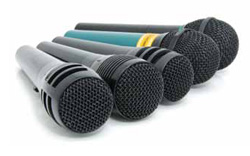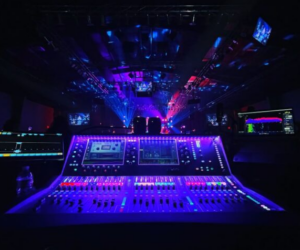While it’s true that vocal microphones can do double duty on instruments, only select models do both jobs well.
Simply put, vocal mics are optimized for voice – many have a presence peak, or a boost in a band of upper midrange frequencies. This enhances the articulation and intelligibility of voices, but when applied to instruments, it can add coloration that’s detrimental.
Vocal mics also tend to roll off lower end frequencies (below the voice range) to help eliminate handling noise and stage rumble, which is not a desired characteristic if you want to use the mic on instruments that produce low frequencies.
General-purpose instrument mics with a flatter and wider frequency response supply a more natural and realistic sound of the instrument to the PA.
Instrument mics optimized for particular types of instruments have tailored responses and features like custom mounting clips and/or adapters to meet the needs of specific applications. The downside is that they might be so specialized that they’re ill-suited for other uses.
Dynamic models are still the most common, and they’re generally rugged and reliable. They work on the principle of electromagnetic induction, similar to a loudspeaker but in reverse.
Dynamics used to come in just two flavors: medium and large diaphragm, the latter intended for instruments that produce bass frequencies. Now, several small-diaphragm dynamics are available to be tucked into tight spaces, nestled between drums, and clipped on to instruments.
Condenser designs have gained in popularity, with lighter diaphragms that can respond more quickly, making them very well suited in reproducing a wide range of frequencies, particularly those at the higher end of the spectrum. The downside is that the diaphragm is not connected to a coil mass and thus require a power source (phantom power or batteries).
The vast majority of vocal and instrument mics are unidirectional, with pickup patterns including cardioid, supercardioid and hypercardioid. In general, they reject sounds from directions other than the front (at various degrees), and this is highly desirable given all of the noise on a typical stage as well as from the house.
Cardioid mics are more forgiving to a singer’s technique and the angle at which the mic is addressed.
Supercardioid mics are more focused to favor sounds from the front and have greater attenuation at their sides – about 10 dB – exhibiting minimum sensitivity 140 to 150 degrees off axis, with a minor secondary response lobe at their rear.
Hypercardioid microphones are even slightly more focused and distinguished by minimum response 110 to 120 degrees off-axis at the expense of a slightly larger rear response lobe.
Both super and hyper designs allow less “stage wash” or background sounds in than cardioid models. When using floor monitors, they are less susceptible to feedback, and they’re generally more useful in loud stage environments.
Sensitivity specs indicate how much voltage appears at a mic’s output when a 1,000 Hz tone is heard at its diaphragm. The reference of 94 dB, or 1 Pascal, is typical of the sound intensity of talking at a distance of an inch.
An alternate reference of 74 dB, one-tenth of a Pascal or a “microbar,” is typical of a talker a foot distant, but these measurements are easily converted by adding 20 dB. We’ve converted all specs to dBV (0 dB = 1 V/Pa 1,000 Hz) for ease of comparison.
What the sensitivity rating tells us is the loudness of the mic’s output. The lower the negative dB number, the louder the output. For very soft instruments, choosing a mic that has a louder output may keep you from having to crank up the preamp and raising the noise floor on that channel.
Impedance is the opposition that resists the flow of the electric current through the conductor, and this resistance is measured in ohms. Mics can have impedance as high as 100,000 ohms, but in this case, smaller numbers are better.
Professional mics have impedances between 50 and 600 ohms, and this allows them to be used with long cables. A microphone with 150-ohm impedance can drive signal more than 400 feet on a typical mic cable, with only slight loss of higher frequencies.
Take our Real World Gear Gallery Tour of a wide range of vocal and instrument microphones currently available for live applications.
















